What is the difference between 70-S and 80-S ribosomes? They are classified based on their sedimentation rate. ‘S’ is the non-SI metric unit, expressed as Svedberg’s Unit, that denotes the sedimentation coefficient of the ribosomes.
The particle size of ribosomes in prokaryotic and eukaryotic cells differs, due to which they sediment at different rates when centrifuged. Thus, the sedimentation coefficient is the basis for classifying ribosomes.
The sedimentation coefficient of prokaryotic ribosomes is 70. In contrast, the sedimentation coefficient of eukaryotic ribosomes is 80. Thus, this differentiation helps us identify the ribosome’s origin, whether it belongs to the prokaryotic cells or eukaryotic cells.
70-S ribosomes are most common in prokaryotic cells. However, semi-autonomous organelles like mitochondria or chloroplast also have a 70-S type of ribosomes. 80-S ribosomes are the structures common only in eukaryotic cells.
This post highlights the key differences between 70-S and 80-S Ribosomes and the comparison chart. You will also learn the meaning, composition and similarities between the two.
Content: 70-S Vs 80-S Ribosomes
- Comparison Chart
- Definition of Ribosome
- 70-S Ribosomes
- 80-S Ribosomes
- Key Differences
- Similarities
- Conclusion
Comparison Chart
| Properties | 70-S Ribosomes | 80-S Ribosomes |
|---|---|---|
| Occurrence | 70-S ribosomes are prevalently seen in prokaryotes and cell organelles like mitochondria and chloroplast | 80-S ribosomes are exclusively a part of eukaryotic cells |
| Origin | They are synthesized in the cell cytoplasm | They are synthesized in the cell nucleolus |
| Size | Comparatively smaller than the 80-S ribosomes | They appear larger in size |
| Sedimentation coefficient | 70 | 80 |
| Molecular weight | 2.8 X 106 D | 4 X 106 D |
| Type | 70-S ribosomes are mostly free-floating types | 80-S ribosomes can be free-floating or membrane-bound |
| Large subunit | 50-S | 60-S |
| Small subunit | 30-S | 40-S |
| Components of larger subunit | 5-S rRNA, 23-S rRNA and nearly 34 proteins | 5-S rRNA, 5.8-S rRNA, 28-S rRNA and about 40 proteins |
| Components of smaller subunit | 16-S rRNA and about 21 proteins | 18-S rRNA and about 33 proteins |
| Total ribosomal RNA | Three types | Four types |
| Total ribosomal proteins | 55 proteins | 73 proteins |
| RNA-Protein ratio | 2:1 | 1:1 |
Definition of Ribosome
Ribosomes are complex biomolecules having a granular structure. They consist of ribosomal proteins and rRNAs, hence are also called ribonucleoprotein particles. Ribosomes are the centres assisting protein synthesis or gene translation.
They have one large and one small subunit, and they associate during the time of protein synthesis. A small subunit binds to a large subunit and the messenger-RNA strand. A large subunit binds to the transfer-RNA, the amino acids, and the smaller subunit.
The functional ribosome has A, P and E binding sites, and during translation:
- A-site is the aminoacyl site holding aminoacylated tRNA.
- P-site is the peptidyl site that holds the tRNA with a nascent peptide chain.
- E-site is the exit site occupied by the deacylated tRNA, which exits after peptide bond formation.
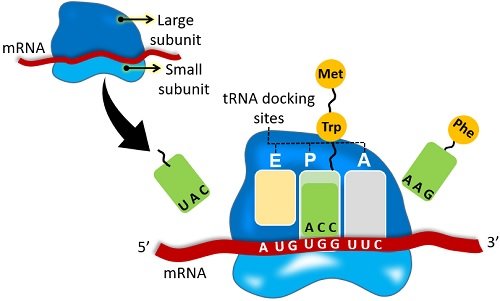
Based on the sedimentation coefficient, ribosomes are categorized into 70-S and 80-S types of ribosomes. According to the structure of the ribosome, both 70-S and 80-S ribosomes consist of one larger and one smaller subunit with different rRNA and proteins.
70-S Ribosomes
They are most often seen in prokaryotic cells and are called prokaryotic ribosomes. But, semi-autonomous cell organelles like mitochondria and chloroplast also have 70-S type ribosomes.
Prokaryotic ribosomes appear roughly spherical and granular within the cell cytosol. They are primarily free-floating types, i.e. dispersed throughout the cell cytosol.
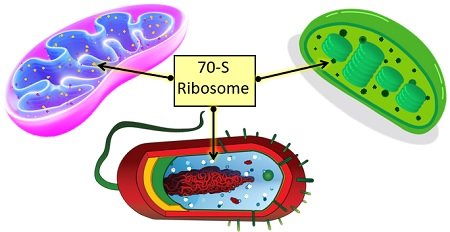
70-S type of ribosomes are smaller in size and comprises two unequal subunits.
- 50-S is the large subunit
- 30-S is the small subunit
The 50-S subunit has 5-S rRNA and 23-S rRNA, while the 30-S subunit contains a 16-S rRNA. The picture below illustrates the structure and components of 70-S ribosomes.
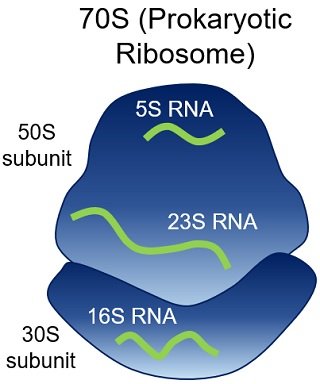
80-S Ribosomes
They are common only in eukaryotic cells and are called eukaryotic ribosomes. 80-S ribosomes also appear granular and can be free-floating or membrane-bound.
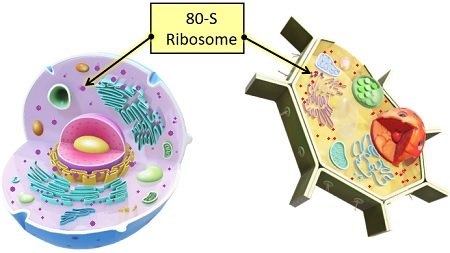
Ribosomes are bigger and more complex in eukaryotic cells, comprising two unequal subunits.
- 60-S is the large subunit
- 40-S is the small subunit
The 60-S subunit of eukaryotic ribosomes comprises 5-S rRNA, 23-S rRNA and 28-S rRNA. Here, the 28-S rRNA is functionally related to the 23-S rRNA of the 50-S subunit of prokaryotic ribosome.
The 40-S subunit of eukaryotic ribosomes has an 18-S rRNA, similar to a 16-S rRNA of the 30-S subunit of prokaryotic ribosomes.
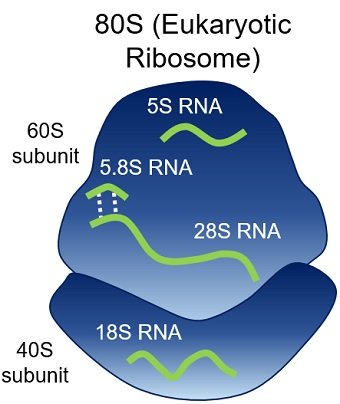
The picture above depicts the structure and components of 80-S ribosomes.
Key Differences Between 70-S and 80-S Ribosomes
- Prokaryotes like bacteria and eukaryotic cell organelles (mitochondria and chloroplasts) have 70-S ribosomes. Oppositely, 80-S ribosomes are typically a part of eukaryotic cells.
- The 70-S ribosome in prokaryotic cells originates within the cell cytoplasm. In contrast, the synthesis of 80-S ribosomes is in the cell nucleolus.
- The particle size or diameter of 70-S ribosomes is about 20 nm which is comparatively smaller than the particle size of 80-S ribosomes (25-30 nm).
- As 80-S ribosomes are larger, with a high molecular weight of 4 X 106 D than the 70-S ribosomes, those have a molecular weight of about 2.8 X 106 D.
- 70-S type ribosomes float freely in the cytosol, while 80-S type ribosomes are either scattered in the cytoplasm or attached to the organelles like RER and the nuclear membrane.
- 70-S type ribosome has a 50-S larger subunit and a 30-S smaller subunit. On the contrary, an 80-S type ribosome has a 60-S larger subunit and a 40-S smaller subunit.
- The composition of 70-S and 80-S ribosomes differs in the type and number of rRNA and ribosomal proteins. A 70-S type ribosome contains a total of three types of rRNA (5-S, 23-S and 16-S rRNA) and about 55 ribosomal proteins. An 80-S type ribosome comprises four kinds of rRNA (5-S, 5.8-S, 28-S and 18-S rRNA) and about 73 ribosomal proteins in total.
Similarities
- Both function as workbenches for protein synthesis.
- Furthermore, they are ribonucleoprotein complexes consisting of rRNA and proteins.
- Besides, the small subunit of the 70-S ribosome and 80-S ribosome has a single rRNA strand.
Conclusion
Both 70-S and 80-S ribosomes participate in making proteins or handling translation. Ribosomes decode the mRNA sequence and translate it into an amino acid sequence to form specific proteins. The proteins synthesized by ribosomes are necessary for both prokaryotic and eukaryotic cells to carry out cellular functions.